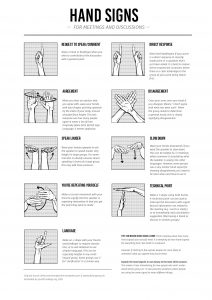
Download the A3 file here to use in your social space. Thanks go to diskussionshandzeichen.wordpress.com and seedsforchange.co.uk for having good graphics and explanations!
Here the text:
Request to Speak/Comment
Raise a hand or forefinger when you wish to contribute to the discussion with a general point.
Direct response
Raise both forefingers if your point is a direct response to recently made point or a question that’s just been asked. It is best to reserve direct response for occasions where there is a clear advantage to the group of your point being heard first.
Agreement
When you hear an opinion that you agree with, wave your hands with your fingers pointing upwards by the sides of your body, around shoulder/face height. This lets everyone see how many people agree & saves a lot of time.
Originally taken from British Sign Language, it means applause.
Disagreement
Cross your arms over your head if you disagree. Means: ‘I don’t agree with what has been said’. When the group needs to determine a general mood, this is clearly signifying disagreement.
Speak louder
Wave your hands upwards to ask the speaker to speak louder. Very helpful in large groups. For someone who is already nervous about speaking in front of a large group this may add more pressure.
Slow down
Wave your hands downwards if you want the speaker to slow down. This can be helpful f.e. in meetings where someone is translating what the speaker is saying into other languages. However, some groups use a very similar hand signal for showing disagreement, you need to be clear when and how to use it.
You’re repeating yourself
Make a circular movement with your hand to signify that the speaker is repeating themselves & that you get the point they want to make.
Technical Point
Make a T shape using both hands. A ‘technical point’ can be used to interrupt the discussion with urgent factual information not related to the meeting (e.g. ‘Lunch is ready’), or to immediately add a facilitation suggestion (like having a break or discuss in smaller groups).
Language
Make an L shape with your thumb and forefinger to request translation, or to ask someone to use
simpler language. This can be especially helpful in any multi-lingual group. Some groups use ‘C’ for ‘clarification’ in a similar way.
Tips for making hand signals work
Think carefully about how many hand signals you actually need. It is tempting to have hand-signals for everything from ‘tea break’ to ‘proposal’.
However, if sticking to few signals people are more likely to remember what you agreed they would mean.
Explain the hand signals in use clearly at the start of the session. This makes it less intimidating for new people who don’t understand what’s going on! It also prevents situations where people are using the same signal to mean different things.
Original source: diskussionshandzeichen.wordpress.com & seedsofchange.org.uk
translated by qsu070.noblogs.org, 2020.